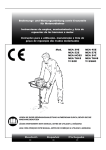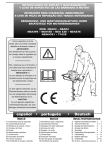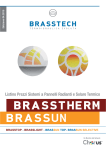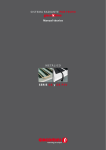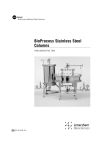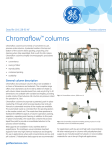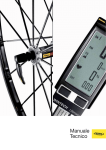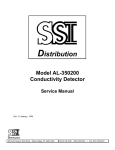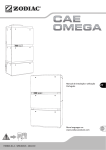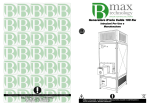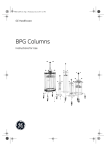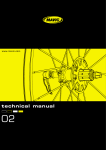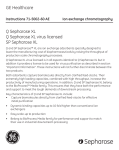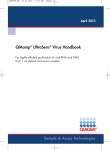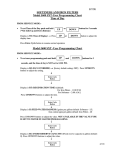Download BioProcess HPLC Columns Instructions for Use
Transcript
user manual BioProcess HPLC Columns BioProcess HPLC Columns Instructions for Use um 56-3225-40 AB Important user information All users must read this entire manual to fully understand the safe use of the BioProcess HPLC columns. CE Certification This product meets all requirements of applicable CE directives. A copy of the corresponding declaration of conformity is available on request. The CE symbol and corresponding declaration of conformity is valid for the instrument when it is: - used as a stand-alone unit, or - connected to other CE-marked Amersham Biosciences instruments, or - connected to other products recommended or described in this manual, and - used in the same state as it was delivered from Amersham Biosciences, except for alterations described in this manual. Terms and Conditions of Sale Unless otherwise agreed in writing, all goods and services are sold subject to the terms and conditions of sale of the company within the Amersham Biosciences group that supplies them. A copy of these terms and conditions is available on request. Should you have any comments on this product, we will be pleased to receive them at: Amersham Biosciences AB SE-751 84 Uppsala Sweden Trademarks BioProcess and Drop Design are trademarks of Amersham Biosciences Limited. Amersham and Amersham Biosciences are trademarks of Amersham plc. Triton is a trademark of Union Carbide Chemicals and Plastic Company Inc. Office Addresses Amersham Biosciences AB SE-751 84 Uppsala Sweden Amersham Biosciences UK Limited Amersham Place Little Chalfont Buckinghamshire England HP7 9NA Amersham Biosciences Corp 800 Centennial Avenue PO Box 1327 Piscataway NJ 08855 USA Amersham Biosciences Europe GmbH Munzinger Strasse 9 D-79111 Freiburg Germany Amersham Biosciences K.K. Sanken Building 3-25-1 Hyakunincho, Shinjuku-ku Tokyo 169-0073 Japan Amersham Biosciences China Limited 13/F., Tower I Ever Gain Plaza 88 Container Port Road Kwai Chung, New Territories Hong Kong © Copyright Amersham Biosciences AB - 2003 All rights reserved Safety Notices This Instructions for Use contains safety notices prompting you on correct use of the column to avoid personal injury and/or damage of the equipment, or to present information that can optimize your use of the columns. The various types of safety notice include: Warning notices WARNING! The Warning notice highlights instructions that must be strictly followed in order to avoid personal injury. Do not proceed until the instructions are clearly understood and all stated conditions are met. Caution notices CAUTION! The Caution notice highlights instructions or conditions that must be followed to avoid damage to the product or to other equipment. Do not proceed until the instructions are clearly understood and all stated conditions are met. Important notices IMPORTANT! The Important notice highlights instructions or details relating to instructions that will help ensure optimal use of the column. Notes Note: Notes are used to indicate additional tips and information for troublefree and optimal use of the product. Contents 1 Introduction 1.1 Scope of this Instructions for Use . . . . . . . . . . . . . . . . . . . . . 1 1.2 Approved operators . . . . . . . . . . . . . . . . . . . . . . . . . . . . . . . 2 1.3 Intended use of the columns . . . . . . . . . . . . . . . . . . . . . . . . . 2 1.4 Safety precautions . . . . . . . . . . . . . . . . . . . . . . . . . . . . . . . . 2 1.5 Labelling of the column . . . . . . . . . . . . . . . . . . . . . . . . . . . . 3 2 Specifications and characteristics 2.1 Primary specifications . . . . . . . . . . . . . . . . . . . . . . . . . . . . . 5 2.2 Materials . . . . . . . . . . . . . . . . . . . . . . . . . . . . . . . . . . . . . . . 5 2.3 Chemical resistance. . . . . . . . . . . . . . . . . . . . . . . . . . . . . . . 6 2.4 Column bed heights . . . . . . . . . . . . . . . . . . . . . . . . . . . . . . . 6 3 Installing the column 3.1 Removing the column from its packaging. . . . . . . . . . . . . . . . 7 3.2 Connecting the column tube to the frame. . . . . . . . . . . . . . . . 7 3.3 Identifying the column components . . . . . . . . . . . . . . . . . . . . 7 3.4 Column connections . . . . . . . . . . . . . . . . . . . . . . . . . . . . . . . 8 3.5 Filling the compression fluid tank . . . . . . . . . . . . . . . . . . . . . 8 3.6 Surface cleaning . . . . . . . . . . . . . . . . . . . . . . . . . . . . . . . . . 8 4 Operation 4.1 Calculating the amount of medium needed. . . . . . . . . . . . . . . 9 4.2 Preparing the slurry . . . . . . . . . . . . . . . . . . . . . . . . . . . . . . . 9 4.3 Filling the column. . . . . . . . . . . . . . . . . . . . . . . . . . . . . . . . 10 4.4 Packing the medium. . . . . . . . . . . . . . . . . . . . . . . . . . . . . . 11 4.5 Performing a run . . . . . . . . . . . . . . . . . . . . . . . . . . . . . . . . 12 4.6 Unpacking the medium from the column . . . . . . . . . . . . . . . 12 4.7 Cleaning-in-Place (CIP) . . . . . . . . . . . . . . . . . . . . . . . . . . . 13 4.8 Storage . . . . . . . . . . . . . . . . . . . . . . . . . . . . . . . . . . . . . . . 13 Introduction 1 Introduction BioProcessTM HPLC columns are stainless steel columns designed for use in scale up chromatographic separations in a sanitary environment. HPLC columns can be operated in conditions of up to 100 bar. HPLC columns are fully scalable in the ranges 50 to 1000 mm column diameter. The columns feature dynamic axial compression that uses solvent as the compression fluid. Together with a specially designed flow distribution system fitted at both the top and bottom of the column, this ensures a uniform distribution of the mobile phase across the whole bed. An adapter, in the form of a piston, is used to regulate the bed height. 1.1 Scope of this Instructions for Use This Instructions for Use is designed as a general introduction and guide to column operation. Specifically, the Instructions will cover: • Column specifications and characteristics, including information on column function, column specifications, materials and chemical resistance (Chapter 2). • Preparing a column for use, including installation, assembly of column components, and pre-run cleaning (Chapter 3). • Operation, including some suggested recommended methods for column filling, packing, unpacking, CIP, and storage (Chapter 4). An accompanying manual, “BioProcess HPLC Columns Maintenance Guide”, covers the following topics: • Safety (Chapter 1). • Column disassembly and assembly (Chapter 2). • Troubleshooting (Chapter 3). • p1 1 Introduction 1.2 Approved operators To be able to use the BioProcess HPLC columns, you must have read, understood and be acquainted with the Instructions for Use. However, this does not guarantee user safety - it is the responsibility of the user’s company to ensure safe operation and training. Training courses are available and can be arranged by contacting your local Amersham Biosciences representative. 1.3 Intended use of the columns BioProcess HPLC columns are designed for production scale separations. IMPORTANT! BioProcess HPLC columns are specified to operate at pressures (defined as the pressure in excess of ambient [1 bar]) up to 100 bar, and consequently the local authorities may consider them to be pressure vessels. Users of the columns are responsible for ensuring that the columns are installed and handled in accordance with the local regulations. 1.4 Safety precautions Information given in this Instructions for Use is suggested best working practice and shall in no way take precedence over individual responsibilities or local regulations. Great effort has been placed on the design and manufacture of the various parts of the equipment so that it will comply with all applicable safety aspects for this type of equipment. During the operation and during other work with a pressurized vessel, it is always each individual's responsibility to consider: • Their own and others' personal safety. • The safety of the equipment through correct use in accordance with the descriptions and instructions given in this Instructions for Use. WARNING! Always use protective clothing appropriate with current application to ensure personal safety during operation. WARNING! Pay extra attention when moving the adapter as there is a risk for trapping your hands. WARNING! Do not exceed the rated pressure of the incoming air supply, otherwise there is a risk of personal injury and damage to the instrumentation. • p2 1 Introduction IMPORTANT! Whenever a BioProcess HPLC column is used, always keep the Instructions for Use on hand. IMPORTANT! The end user must ensure that all installation, maintenance, operation and inspection is carried out by qualified personnel who are adequately trained and understand the operating instructions. 1.5 Labelling of the column The BioProcess HPLC columns are labelled as follows: Fig 1-1. The BioProcess HPLC column rating plate. • p3 1 Specifications and characteristics 2 Specifications and characteristics BioProcess HPLC columns feature hydraulic movement of the adapter to pack the medium. This is achieved using the in-built packing station on the column frame. A pump located in the base of the frame uses compressed air to push compression fluid (ethanol) from a storage tank into the hydraulic chamber of the column and thereby push the adapter upwards to pack the medium. Lid mobile phase Lid Adsorbent Adapter Compression fluid Pressure outlet Base end plate Air inlet Adapter rod Adapter mobile phase Compression fluid tubing Compression fluid tank Pump Fig 2-1. General construction of a BioProcess HPLC column. BioProcess HPLC columns comply with the technical performance 100 bar in industrial BioProcessing. In addition, they withstand temperatures up to 50 °C. Construction is in stainless steel AISI 316 L, and the sanitary design includes Quick Connections. Sealing materials are resistant to organic solvents and a leakage detection system is included. Table 2-1 gives the primary specifications of selected columns. Table 2-2 lists the materials of the main column components, and Table 2-3 the chemical resistance. • p4 2 Specifications and characteristics 2.1 Primary specifications Table 2-1 Properties of selected BioProcess HPLC columns. Designation Size DxL (mm) CrossMax. sectional column area vol. (L) (cm2) Overall Dry column ht. weight (mm) - adapter (kg) in top pos. HPLC 50/700 50x700 19.6 1.4 2100 100 HPLC 75/700 75x700 44.2 3.1 2100 150 HPLC 100/700 100x700 78.5 5.5 2200 200 HPLC 150/700 150x700 176.7 12.4 2200 250 HPLC 200/700 200x700 314.2 22.0 2200 300 HPLC 250/700 250x700 490.9 34.4 2200 375 HPLC 300/700 300x700 706.8 49.5 2400 475 HPLC 450/700 450x700 1590.0 111.3 2800 650 HPLC 600/700 600x700 2827.4 197.9 2800 1000 2.2 Materials Table 2-2. Materials of main components. Component Material In contact Column tube Stainless steel 316 L Yes Base end plate (‘Top’)* Stainless steel 316 L No Adapter and adapter rod Stainless steel 316 L Yes Distributor PE or Stainless steel 316 L Yes Lid (‘Bottom’)* Stainless steel 316 L Yes Net Stainless steel 316 L Yes Sealings FEP encapsulated Viton, PTFE, PE Yes Valves Stainless steel 316 L Yes PE = polyethylene, FEP = fluoroethenepropene, PTFE = polytetrafluoroethene. * For maintenance purposes and ordering of spare parts the HPLC columns are labelled in the upright position, that is with the adapter pushing down into the column. This orientation is used for designating top and bottom of the column. However, the HPLC columns are packed and run in the inverted upright position, that is with the adapter pushing upwards into the column. Thus the ‘top’ and ‘bottom’ labels also become inverted. The end plates are thus referred to as the ‘lid’ and ‘base end plate’ according figure 2-1. • p5 2 Specifications and characteristics 2.3 Chemical resistance Table 2-3. Chemical resistance of BioProcess HPLC columns Chemical SS 316L EPDM FEP PEEK 450 G PE PTFE Acetic acid 1.7 M + + + + + + EtOH 20% + + + + + + EtOH 40% + + + + (+) + Ethylene glycol 50% + + + + + + Formaldehyde 1.7 M + + + + + + Formic acid 10% + + + + + + Glycerol 100% + + + + + + Hydrochloric acid 0.1 M - + + + + + Isopropyl alcohol 30% + + + + (+) + Nitric acid 0.1 M + + + + (+) + Phosphoric acid 25% (+) + + + + + Sodium chloride 0.5 M + 1) + + + + + Sodium hydroxide 2 M 2) + + + + + + Trifluoroacetic acid 0.1% + + + + + + Triton™ X-100 100% + + + + + + UREA 8 M + + + + + + + Resistant (+) Limited resistance - Not recommended 1) NaCl can cause corrosion on stainless steel at pH <5. Do not use NaCl in storage solutions. 2) Maximum exposure 4 hours. SS=stainless steel, EPDM=ethylene propylene diene, FEP=fluoroethenepropene, PEEK=polyetherether ketone, PE=polyethylene, PP=polypropylene, PTFE=polytetrafluoroethene. 2.4 Column bed heights To calculate the bed height in your particular column, please refer to the documentation supplied with your column or contact your local Amersham Biosciences representative. • p6 2 Installing the column 3 Installing the column 3.1 Removing the column from its packaging Place the transport box on an even foundation and remove the side that has been fastened with screws. Roll out the column frame on its wheels. IMPORTANT! Make sure that the column is placed on an even foundation. 3.2 Connecting the column tube to the frame Unpack the column tube and fix it to the frame using the bracket on the frame. For the 50 mm diameter column, make the attachment halfway along the column tube length. The BioProcess HPLC column is now ready for installation and use. 3.3 Identifying the column components The columns are supplied together with mobile phase and compression valves, and a frame-mounted packing station that includes pump, safety valve, pressure gauges, valves and a regulator (see figure 3-1). G. Lid mobile phase valve H. Column tube I. Fixture device A. Hydraulic chamber valve B. Compression fluid tank C. Adapter rod with (D.) adapter mobile phase connection E. Air pressure regulator F. Compression pump J. Air pressure K. Column pressure L. Tubing for compression M. Air valve N. Air Connection O. Hydraulic flow direction switches Fig 3-1. Schematic diagram of a BioProcess HPLC column • p7 3 Installing the column 3.4 Column connections Compressed air is connected to the AIR CONN connection (N), which is used by the pump (F) to push compression fluid from the compression fluid tank (B) into the hydraulic chamber of the column via the compression tubing (L). Feedstock can be applied either upflow or downflow via the adapter mobile phase connection (D) or lid mobile phase valve (G), respectively. The lid mobile phase valve (G) is a 2 way, three port valve. 3.5 Filling the compression fluid tank Prior to a run, fill the compression fluid tank with ethanol (suitable concentration to inhibit microbial contamination). There is a cap for filling purposes on the frame of the stand. The level of the compression fluid can be seen by the indicator on the frame. 3.6 Surface cleaning Amersham Biosciences recommends that you clean the outside of the column with, for example warm water and/or 20%(v/v) ethanol to remove any surface residues acquired during removal from the packaging. • p8 3 Operation 4 Operation IMPORTANT! Various methods are available for operating the BioProcess HPLC columns. The procedure presented in this chapter describes preparing the column for a run upflow. For specific information on the best methods to meet your needs please contact your Amersham Biosciences representative. 4.1 Calculating the amount of medium needed The compression factor of the medium can be calculated by dividing the settled volume of the medium by the desired packed volume of the medium. The compression factor is anywhere between 1.15 and 1.30 and depends on the specific medium being used. Please check the Instructions supplied with the medium that you are using. 4.2 Preparing the slurry To prepare the medium a slurry-unit is recommended, which consists of a suspension tank with a mixing device, decanting pipe and a slurry pump. Note: A slurry unit for your BioProcess HPLC column can be ordered from Amersham Biosciences. Please contact your local Amersham Biosciences representative. • p9 4 Operation 4.3 Filling the column G. Lid mobile phase valve H. Column tube I. Fixture device A. Hydraulic chamber valve B. Compression fluid tank C. Adapter rod with (D.) adapter mobile phase connection E. Air pressure regulator F. Compression pump J. Air pressure K. Column pressure L. Tubing for compression M. Air valve N. Air Connection O. Hydraulic flow direction switches Fig 4-1. Schematic diagram of Bioprocess HPLC column. The following section assumes that the column is empty and shall be packed with fresh medium. If however the column needs first to be emptied please see 4.6“Unpacking the medium from the column” on page 12. 1. Remove the lid on the column tube: Lock the column in its inverted upright position as shown in figure 4-1. Loosen and remove the bolts connecting the lid to the column tube. The lid may then be removed using a suitable hoist or crane. Note: To help remove the lid you may need to insert T-shaped jacking bolts into threaded holes on the lid. Screwing these in will help to release the lid. • p10 4 Operation 2. Withdraw the adapter to its most extreme position: Set both of the hydraulic flow direction switches (O) to the FROM COLUMN position. CAUTION! Both hydraulic flow direction switches (O) must be moved to the same position before starting the pump. A high pressure can build up inside the tubing from the pump if the left switch is set to TO COLUMN and the right switch to FROM COLUMN. Set the AIR ON/OFF switch (M) to ON and use the air pressure regulator (E) to set the air pressure (J) to an appropriate pressure (e.g. 0.5 bar for 50 mm diameter columns). The adapter will move out of the column by itself. When the adapter is fully extended turn off the air pump (M). 3. Gently swirl the slurry an extra time and pour the appropriate amount into the open end of the column tube. 4. Replace the lid using the bolts. 4.4 Packing the medium 1. Direct the outlet valve (G) to the waste port. 2. Start the compression: Set both of the hydraulic flow direction switches (O) to the TO COLUMN position. CAUTION! Both hydraulic flow direction switches (O) must be moved to the same position before starting the pump. A high pressure can build up inside the tubing from the pump if the left switch is set to TO COLUMN and the right switch to FROM COLUMN. Set the AIR ON/OFF switch (M) to ON and use the air pressure regulator (E) to set the air pressure (J) and thereby raise the hydraulic pressure (K) to achieve your target volume. IMPORTANT! Begin packing with a lower hydraulic pressure, for example 20 bar. • p11 4 Operation The adapter moves into the column tube driven by the compression fluid. Fluid from the slurry is pushed out of the outlet valve (G) as the bed is compressed and packed. Packing continues until no more drops of fluid come from the waste pipe connected to the outlet valve (G). 3. Adjust the column pressure (K) to the final pressure using the air pressure regulator. Keep the pump running to maintain the packing. 4.5 Performing a run For the procedure described here, feedstock is entered into the bed via the adapter mobile phase (D) through the shaft of the adapter rod (C). An upwards flow is created and fluid exits the bed through the lid mobile phase valve (G), where it can then be directed to one of two ports from the valve. Perform a run according to you own procedures. Contact you local Amersham Biosciences representative for further advice and information. 4.6 Unpacking the medium from the column After you have completed your run(s) and wish to unpack the medium first perform a CIP procedure (see 4.7“Cleaning-in-Place (CIP)” on page 13). To unpack the column: 1. Turn off the pump pressure with the regulator (E). 2. Release residual pressure in the column tube by opening the hydraulic chamber valve (A). Collect the hydraulic fluid in a suitable container. 3. Remove the lid on the column tube: Lock the column in its inverted upright position as shown in figure 4-1. Loosen and remove the bolts connecting the lid to the column tube. The lid may then be removed using a suitable hoist or crane. Note: To help remove the lid you may need to insert T-shaped jacking screws into threaded holes on the lid. Screwing these in will help to release the lid. 4. Invert the column 180 degrees so that the pellet can later be easily collected in a container. 5. Set the hydraulic flow direction switches (O) to the TO COLUMN position. • p12 4 Operation CAUTION! Both hydraulic flow direction switches (O) must be moved to the same position before starting the pump. A high pressure can build up inside the tubing from the pump if the left switch is set to TO COLUMN and the right switch to FROM COLUMN. Set the AIR ON/OFF switch (M) to ON and use the air pressure regulator (E) to set the air pressure (J) to an appropriate level to push the adapter. As the adapter moves further into the column tube it pushes out the packed medium pellet. Catch the medium pellet in a suitable container. 6. Turn off the air pump (M). 7. Clean the adapter, lower bed support on the adapter, and the opening of the column tube with ethanol or other suitable cleaning agent and lint-free tissue paper. 8. Return the adapter to its extended position (see 4.3“Filling the column” on page 10, step 2) 4.7 Cleaning-in-Place (CIP) You are recommended to use a CIP method suitable for the procedure and medium that you are using. Please contact your local Amersham Biosciences representative for advice. 4.8 Storage With the packed medium in the column, pump in an upward direction at least 2-5 sedimented bed volumes of 20% ethanol and/or 10 mM NaOH or other appropriate solution, at a flow rate of 100 cm/h. Seal the column valves and store the column at room temperature. • p13 4



















